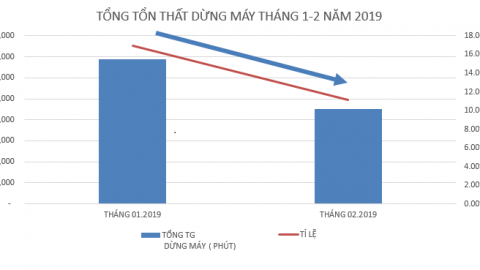
Comparison chart of total losses due to outages in January - February 2019 of Cuong Vinh Company
The successful implementation of TPM tool will help businesses improve quality productivity. This is one of the important goals set in the 712 program
For example, applying the TPM improvement tool (Maintaining overall equipment performance), the Cuong Vinh Company has achieved many practical results, such as reducing 5.8% of downtime and improving efficiency production results at Aluminum Foundry.
Since October 2018, the Company has established a TPM board with the participation of many departments (Deputy General Director with the role of Head of TPM, Production Director, Director of Human Resources in charge of effective supervision, Manager workshop – deputy head – directly running TPM activities at the workshop) and set the goal of improving the operator’s capacity (the operator knows what he needs to do before running the machine, in order to mount responsibility responsibilities of equipment operators and maintainers); Reduce downtime due to malfunction.
After the first 3 months, the company has listed the causes of the shutdown. This helps the company to offer suitable immediate solutions to overcome. Since 1/2019, the company has monitored and reduced downtime due to incidents. By February, the company had reduced 5.8% of downtime compared to January 2019.
At the same time, preventive measures are implemented to control downtime due to incidents, such as: Completing the standardized table of molding machine operation, training and evaluating machine operating capacity according to the target table standardize, standardize regulations on the types of errors in production. In addition, the company creates a mechanism for all operating personnel to detect errors, abnormalities, and can report to the shop leader accurately, completely and quickly (using red card tools and information technology).
With the success achieved after only 3 months, the company’s leaders have strongly supported and supported TPM to deploy the pillars of AM, PM, FI, HSE along with maintaining 5S continuity as a foundation for TPM. TPM activities are promoted according to each pillar: training, evaluation, reward, improvement team, reporting improvement results etc.
The TPM board also aims for the last 6 months of 2019 to implement AM pillar in step 7, PM pillar in step 7; expanding TPM activities to the second factory. These are challenging goals, but with the support of TPM of the company’s leadership, the enthusiasm of the TPM board, and the support of the Ministry of Industry and Trade in Chapter In order to improve productivity and quality of Industry and Trade, TPM has committed to the company leaders to achieve these goals.
Or at, Hong Ha Shipyard has started to deploy TPM under the support program of the Department of Science and Technology, Ministry of Industry and Trade. TPM targets are set for each workshop in the factory (M&E workshop, Shipyard workshop, M&E workshop and Motivation workshop).
In April, the factory organized TPM training for managers and operating staff of 4 workshops, thereby starting to implement the Self-maintenance pillar by hanging a red card at the workshop.
After 2 months of deploying, most of the workshops’ employees hanged the red cards as soon as they observed and discovered abnormalities in machines and tools.
From the 3rd month, the factory organizes training of PM pillars (planned maintenance) for factory managers. After the training, important machines and equipment were planned and started following TPM form for incidents.
The implementation of PM pillar will be implemented focusing on phase 1: Eliminating the cause of subjective degradation due to subjective, overcoming and maintenance of basic conditions.
Productivity and Quality Office